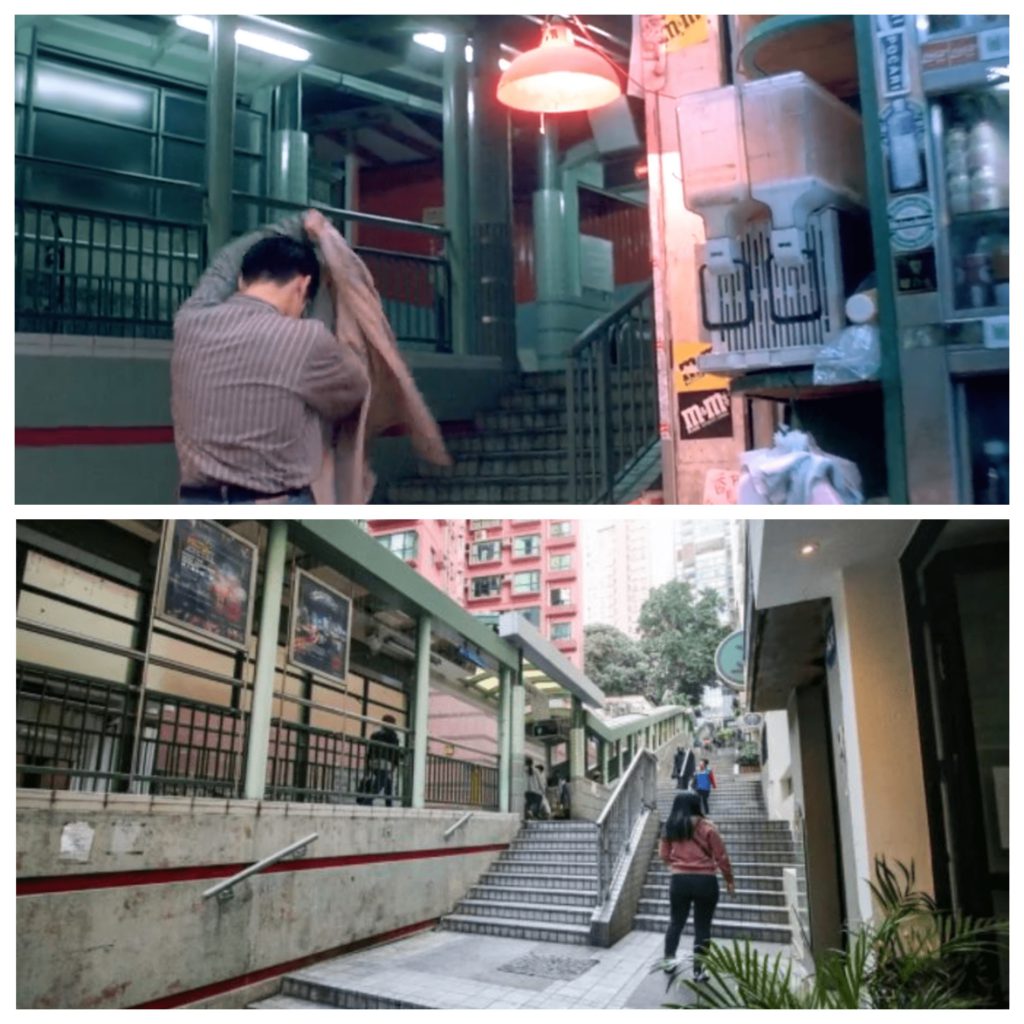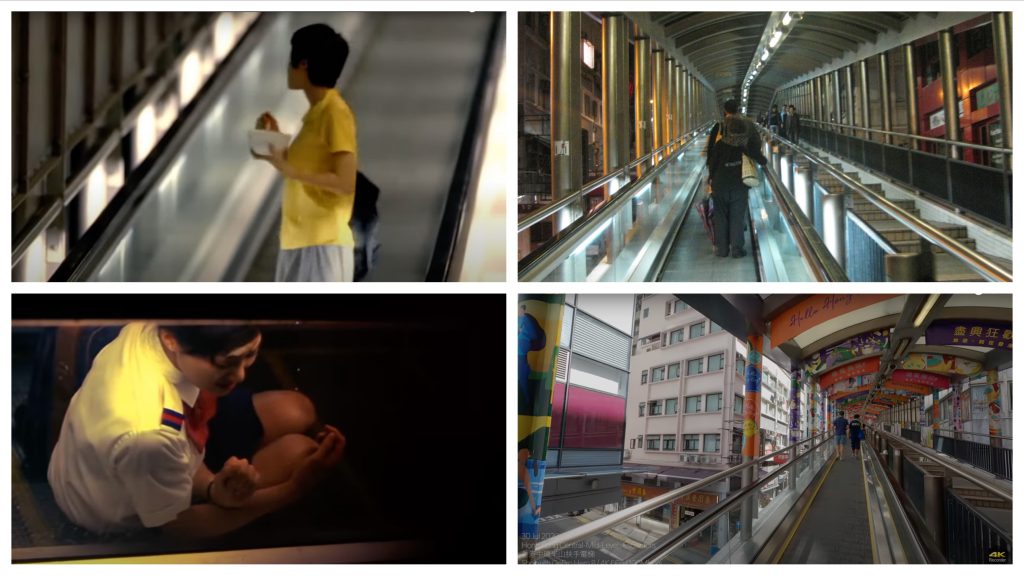CHUNGKING EXPRESS (1994), Dir. Wong Kar Wai
Central-Mid-Levels Escalator and Walkway System, Jubilee St, Central.
Chungking Express, a classic Hong Kong romantic comedy-drama film written and directed by Wong Kar Wai in 1994. The film comprises of two stories, each about a lovesick Hong Kong policeman contemplating his relationship with a woman.
Just like the name of the movie, the movie was mainly shot at a fast-food restaurant “Midnight Express” in Lan Kwai Fong and the Central-Mid-Levels Escalator in Central district. It is the longest outdoor covered escalator system in the world with covers over 800 meters in length and traverses an elevation of over 135 meters from bottom to top. The movie was filmed shortly after the elevator system opened for public use, but the iconic fast-food restaurant “Midnight Express” was replaced by a convenience store a few years later.

Fg.1
Upper: This is the shot when“Ah Wu”(Takeshi Kaneshiro) failed to contact his ex-girlfriend (May)
Below: Live shot of the entrance on one side of the Central-Mid-levels Escalator.
Comparing how the Central-Mid-Levels Escalator is presented in the film and how it is seen and experienced in reality. First and foremost, as most of the incidents in the story is cultivated on the bridge, the utilize of chiaroscuro techniques on emerging the typical red overhead hanging bulb at the front of the grocery store with the stone-cold grey-green tone side entrance presented a strong ambient depth to the audience. There are also propaganda stickers on the walls and refrigerators, and white plastic bags hanging from the beverage machines. Every architecture conveys messages like obsoleted and disorganized, but the ornament is still evidence of Hong Kong’s putative identity that vividly reconstructed how people lived and buy their grocery in the 1990s (Abbas 1997, 87). This scene not only conveys Ah Wu’s pessimism about not be able to contact May, but also symbolizes his psychological change, from holding on to the last hope to giving up.
On the contrary, when grocery store is vanished and the glowing red light is gone, the architecture implies a stronger harmony in terms of their composition and pigment tone. The spatial property in real life also seems less dense and rather exhibit a fast-paced lifestyle. However, sitting in the place where the original filming was taken still gives the audience participating as the flaneur, just like a shopkeeper or a customer who buys vegetables, witnessing the sudden transformation of Ah Wu’s spirit (AlSayyad 2006, 147-168).

Left top: Faye Wong tries to spy on 633 (Tony Leung)’s house in the elevator.
Left bottom: The flight attendant cried in the same elevator.
Right: Day(bottom) and night(upper) Live shot of a session of Central-Mid-levels Escalator.
Here’s two discarded shot taken in the elevator system. In the scene where the flight attendant gave up 633 crying, the surroundings were gloomy, only the limelight projected on her shoulders and the stage composition was “hollow”. This photographic expression helps accentuate the shot and spread grief to it. Paradoxically, when Faye Wong tries to spy on 633’s home, the background setting is rather brighter and less dense, but kept the blurriness. The reason why it is so portrayed is not only to present the face of the place, but also to reflect Faya’s first experience of 633 community life. Hence, the atmosphere depicted in movie seem variable with the context and protagonist’s feeling. Moreover, a strong chiaroscuro can also be experienced in both film and real life, especially at night. The composition in the escalator in real life may be too bland and lacking in depth to reveal people’s emotions, and nonetheless better in depicting and drags people attention into city urban appearance.
In real life, the composition may be too bland and lacking in depth to deeply reveal people’s emotions, but it describes more of the urban look that draws people’s attention to the city. Furthermore, an interesting aspect worth mentioning in this scene is the camera angle, and it seems that there are pedestrians or the male protagonist 633 in the film who play the role of a voyeur watching the two female characters. Admittedly, the audiences may have become voyeurs unwittingly while admiring the film, yet it is also realistic for them, as they can actually violate others privacy for pleasure with a bird’s-eye view when using the elevator (AlSayyad 2006, 147-168).
Tin Yiu, Wong 3035840239
Notes
4K Hong Kong Recorder. (31st July, 2020). 4K Hong Kong Central-Mid-Levels Escalators 香港中環半山扶手電梯. https://www.youtube.com/watch?v=EWZJf6BkKQ4&t=270s
大雄小教室 Hong Kong 4K 60FPS. (8th May, 2021).【HK 4K】中環半山扶手電梯 | Central – Mid-Levels Escalators | DJI Pocket 2 | 2021.05.06. https://www.youtube.com/watch?v=hw6Ij6YX6vE&t=590s
Reference
Abbas, M. A. (1997). Hong Kong: Culture and the politics of disappearance. Hong Kong: Hong Kong University Press.
AlSayyad, N. (2006). Voyeuristic Modernity: the Lens, the Screen and the City. In Cinematic urbanism: A history of the modern from reel to real (pp. 147-168). New York: London: Routledge.
Chungking Express, directed by Wong Kar Wai (1994; Hong Kong: Jet Tone Production, 1994), DVD.
Appreciate your attempt to bring in ideas on urban voyeurism in your discussion of the Central-Mid-Levels escalator in the film and through another’s actual trips in 2020 and 2021. Good observations on the chiaroscuro effects and camera angles. Go for clear writing. There are some statements and phrases that could be more directly stated or need explanation. For example, what is “the ornament” that “is still evidence of Hong Kong’s putative identity”? Does “the architecture” that “implies a stronger harmony” refer to the escalator itself or the space where the grocery store used to be? And, what are you referring to as “the spatial property in real life”? How do “photographic expressions help accentuate the shot and spread grief to it”? Do cite your sources clearly and fully, including the authorship of the photographs of the Central-Mid-Levels escalator. Were the “live shots” taken from 4K Hong Kong Recorder, Hong Kong 4K 60FPS by tinytokage, or yourself?